Tangier International Zone
| Tangier International Zone | |||||
| International Zone | |||||
| |||||
|
| |||||
 Tangier and the International Zone | |||||
| Capital | Tangier | ||||
| Political structure | Special territory | ||||
| Historical era | Interwar period | ||||
| - | Established | 1923 | |||
| - | Spanish occupation | 14 June 1940 - 11 October 1945 | |||
| - | Disestablished | 29 October 1956 | |||
| Area | |||||
| - | 1923 | 373 km² (144 sq mi) | |||
| Currency | British Pound | ||||
| Today part of | | ||||
The Tangier International Zone was a 373 square kilometre international zone centred on the city of Tangier, North Africa under the joint administration of France, Spain, and Britain (later Portugal, Italy, Belgium, Netherlands, Sweden, and the United States) attached to Morocco, then under French protectorate that existed from 1923 until 29 October 1956 with its reintegration into Morocco.
The zone was governed in accordance with the Tangier Protocol, although the Sultan of Morocco retained sovereignty over the zone and jurisdiction over the native population.[1]
The International zone of Tangier had, by 1939, a population of about 60,000 inhabitants and 150,000 by 1950.[2]
History
To solve a disagreement between France, Spain, and Britain of its control, Tangier was made a neutral demilitarised zone in 1923 under the joint administration of under an international convention signed in Paris on December 18, 1923.[3] Although some disagreements emerged about the agreement[4] ratifications were exchanged in Paris on May 14, 1924. The convention was registered in League of Nations Treaty Series on September 13, 1924.[5] The convention was amended in 1928.[6] The governments of Italy, Portugal and Belgium adhered to the convention in 1928, and the government of the Netherlands in 1929.

The Zone had a reputation for diversity of culture, and religion which concerned the pious Moroccan population who saw it as 'a plague zone infested and infected by infidels'.[7]
Spanish troops occupied Tangier on June 14, 1940, the same day Paris fell to the Germans. Despite calls by the writer Rafael Sánchez Mazas and other Spanish nationalists to annex "Tánger español", the Franco regime publicly considered the occupation a temporary wartime measure.[8] A diplomatic dispute between Britain and Spain over the latter's abolition of the city's international institutions in November 1940 led to a further guarantee of British rights and a Spanish promise not to fortify the area.[9] In May 1944, although it had served as a contact point between him and the later Axis Powers during the Spanish Civil War Franco expelled all German diplomats from the Zone.[10] The territory was restored to its pre-war status on October 11, 1945.[11] In July 1952 the protecting powers met at Rabat to discuss the Zone's future agreeing to abolish it. Tangier joined with the rest of Morocco following the restoration of full sovereignty in 1956.
See also
References
- ↑ Stahn, C (2008) The Law and Practice of International Territorial Administration: Versailles to Iraq and Beyond. Cambridge University Press, P57-8
- ↑ "City states". Retrieved 2008-09-21.
- ↑ Stahn, C (2008) The Law and Practice of International Territorial Administration: Versailles to Iraq and Beyond. Cambridge University Press, P57
- ↑ Stuart, GH (1955) The International City of Tangier, Stanford University Press, P80
- ↑ League of Nations Treaty Series, vol. 28, pp. 542–631.
- ↑ Text in League on Nations Treaty Series, vol. 87, pp. 212–251.
- ↑ Finlayson, I (1993) Tangier: city of the dream, University of Michigan Press, P4
- ↑ Payne, S.G. The Franco Regime, 1936–1975. Madison: University of Wisconsin, 1987. 268.
- ↑ Payne 1987, p. 274, note 28.
- ↑ Beevor A (2007) The Battle for Spain, Phoenix, London, P152, 464
- ↑ Benton, Assistant Secretary (October 21, 1945). Reestablishment of the International Regime in Tangiers. 330 XIII. Department of State. pp. 613–618.
